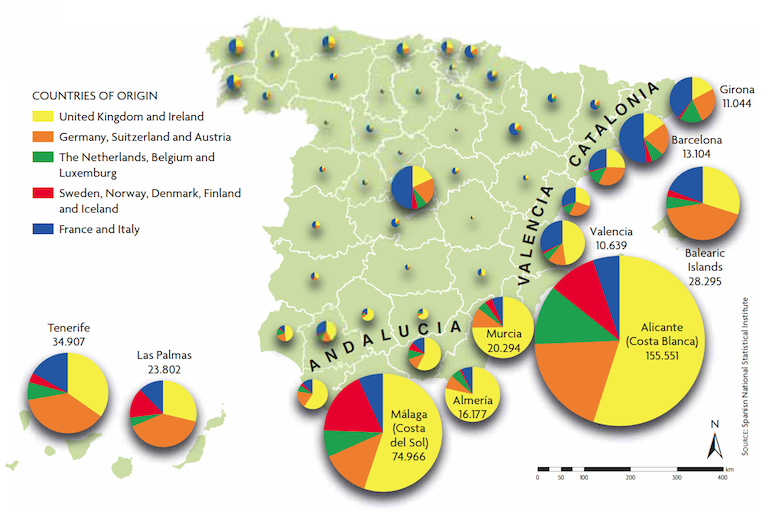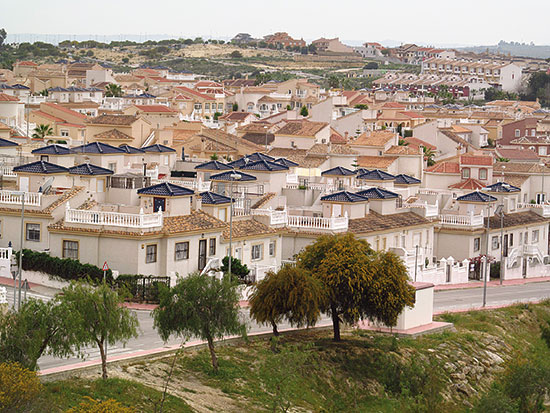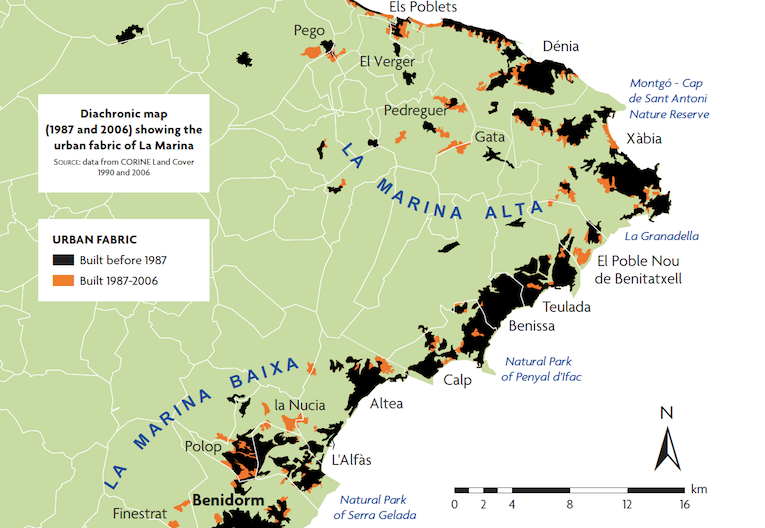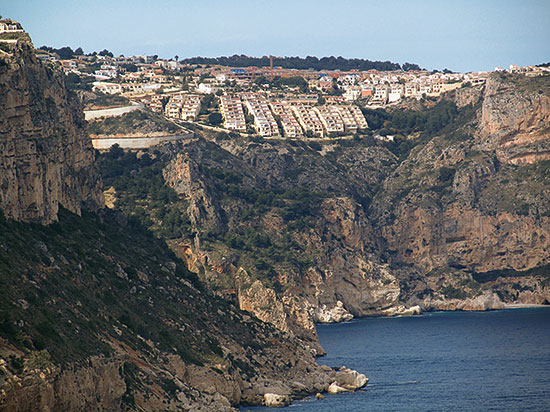Pensioners’ Coast
Migration of elderly north europeans to the Costa Blanca

This paper investigates the cross-border migration of North European retirees to the Costa Blanca and its influence on the urban expansion of resorts. We also discuss the reasons for these migrations, which are mainly related to climate and lifestyle, and we explore the pros and cons and impact on the Costa Blanca landscape and environment.
Keywords: Marina Alta, Baix Segura, urbanisation, coast, territory.
INTRODUCTION
The main aim of this article is to examine the mass migration of northern European retirees to the Costa Blanca. It also analyses the changes in land use, and the economic, social and environmental impacts that migration has had on this region. The influx of northern European immigrants, encouraged by public authorities and large construction companies, has led to urban sprawl in La Marina and La Vega Baja coastal areas. Over 5 million immigrants have moved to Spain during the last two decades, of which some 20% come from countries with a higher GDP per capita than Spain. At least half of these «wealthy» immigrants are retirees, and 95% of them have settled in the warmest and sunniest spots of Spanish territory: the Mediterranean coast, the Canary Islands and the Andalusian Atlantic coast.
«The arrival of northern European immigrants, encouraged by public authorities and large construction companies, has led to urban sprawl in the Marina and La Vega Baja coast»
This type of residential mobility, called lifestyle migration in Anglo-Saxon literature (Oliver, 2007; Benson and O’Reilly, 2009) has recently taken a significant upward trend worldwide (Janoschka and Haas, 2013). In Spain this type of migration is described as «residential tourism», a term coined by Jurdao (1979). Looking back at the history of this migration of retirees to Spain, we find that the tourist boom began in the 1960s, as recorded by Gaviria (1976) among other authors. The remarkable growth in both wealth and life expectancy, which took place in northern Europe from the sixties onward, led to an increase in the number of northern European retirees who could spend their holidays abroad, and many chose to do so near the sunny, and purportedly idyllic, Mediterranean Sea. Then, during the 1980s, some of these tourists were no longer content to spend just their holidays, and decided to take up residence in the Spanish Mediterranean. But it was not until the global economic expansion of the late twentieth and early twenty-first centuries that these northern European retirees settled en masse on the Spanish Mediterranean coast. Indeed, their numbers rocketed from 60,000 in 1991 to almost 450,000 in 2012. This leap in the number of newcomers was due to a combination of factors, among which we should mention low-cost airlines, relatively low housing prices and cost of living in the Mediterranean territories, and global technological development. Several authors have analysed the growth in residential tourists in Spain since 1990 (Rodríguez et al., 1998, 2004, 2005; King et al., 2000; O’Reilly, 2000, 2007; Williams et al., 2000; Casado, 2006; Gustafson, 2009; Huete, 2009; Mazón et al., 2009).

Figure 1. «Rich» immigrants over 55 years old in Spain, divided by provinces. Immigrants who come from countries with higher GDP than Spain are considered «rich».
NORTHERN EUROPEAN IMMIGRANTS IN MEDITERRANEAN SPAIN
Thanks to the fictional wealth produced by the housing bubble, Spain attracted over 5 million immigrants, bringing the proportion of immigrants up to 12.2% in 2010, one of the highest in Europe. However, now the tables have turned due to the current economic crisis, and currently Spain is losing inhabitants, not only some of these immigrants but also many competent young Spaniards, who are being forced to emigrate.
We have to distinguish between two main types of immigrants moving to Spain. On the one hand, there are those coming from regions with a GDP per capita lower than Spain (mainly Eastern Europe, South America and North Africa), who form the majority (80 %). On the other, a minority of immigrants (20 %) originate from countries with a higher GDP per capita than Spain’s (mainly the UK, Germany, Benelux and Scandinavia). Almost half of these «rich» immigrants («rich» meaning they come from countries richer than Spain) are retirees or pre-retirees, whose wealth depends on their pensions and savings. This article deals with the latter group. Among these «retired» immigrants (where «retired» refers to over 55-year-olds, including early retirees), 95 % have settled along the Mediterranean coast, in search of not just a sunny dry climate, but also a new lifestyle (Rodríguez, 2004).
«Most northern European retirees have settled along the Mediterranean coast, in search of a sunny dry climate and a new lifestyle»
These northern European immigrant retirees have chosen to live in Mediterranean Spain for several reasons, including the cost of housing and of living, climate and proximity to the sea, but also the so-called «Mediterranean lifestyle», which implies a better quality and a healthier lifestyle, thanks to a more relaxed pace of life and outdoor activities (Huete et al., 2013: 333). Another reason to consider is the role played by Spanish authorities, which have supported mass tourism, and by real-estate developers, which have attracted potential foreign buyers for Spanish coastal homes.
Real-estate developers are also responsible for the fact immigrants of the same nationality are clustered together in certain areas. This is because developers often ran sales campaigns targeting one country for each development so as to optimise on resources and costs, and generally succeeded. Thus colonies housing people of the same nationality arose, homes sought by the elderly, in particular, who felt more at ease living among their countrymen. Thus, British, German, Dutch, Norwegian colonies… have now become part of a multicultural mosaic (Piqueras, 2011), the greater the number of people from one nationality, the greater their influence. The residents of these colonies are involved in the social and political life of Spain, at least on a local level. Many of these settlers stand for Spanish political parties, and nowadays it is not at all strange to find foreign councillors forming part of the local councils in the more touristic areas of the Mediterranean coast (Janoschka and Duran, 2013).

In Rojales (in La Vega Baja), thousands of single-family homes sprawl throughout the area, which lacks parks, public transport and other public services. / Antoni Martínez Bernat
Spain is the Mediterranean country with by far the largest number of northern European retirees. In 1991, around 60,000 lived here, while by 2012 this figure had reached some 450,000. The most popular areas are the Costa Blanca (with 35.5% of the northern European retirees living in Spain), the Costa del Sol (17.1%), the Canary Islands (13.5%), the Catalan coast (7.1%), the Balearic Islands (6.6%), the Andalucian Mediterranean besides the Costa del Sol (5%) Murcia (4.6%) and the Valencian coast excluding the Costa Blanca (3.4 %), (Figure 1).
With regard to the nationality of these wealthy foreign retirees, Figure 1 highlights five origins, according to the language spoken: British (including a small Irish colony); German (including a small colony of Austrians and an important Swiss colony, most of whom speak German); those from the Benelux (Dutch, Belgian and Luxembourg, who mostly speak Dutch); Nordic (with sizeable colonies from Sweden and Norway); and speakers of Romance languages (French and Italian), who come from countries that are also bathed by the Mediterranean and are, therefore, less attracted to this coast than the Atlantic Europeans are.
«Rapid immigration has led to overcrowding of the Costa Blanca with clear urban sprawl, suburbanisation, excess traffic and land exploitation in general»
French and Italians (60,742; 14% of all wealthy retired immigrants in Spain) make up the majority on those living on the Catalan coast, due to the geographical proximity of their countries of origin. Regarding Scandinavians (36,726; 8.4%), they live mostly in the major tourist resorts such as the Costa Blanca and the Costa del Sol. Retirees from the Benelux (37,844; 8.6%) are also mainly concentrated along the Costa Blanca, and to a lesser extent, the Costa del Sol, whereas German-speakers (95,426; 21.8 %) prefer the Costa Blanca, although there are also large colonies in the Canary islands and the Balearic Islands (these two archipelagos house the largest colony of «wealthy» retired immigrants). The English-speakers (British and Irish), who make up almost half of the «wealthy» retired immigrants (207,274; 47.3 %), prefer to reside on the Costa Blanca and to a lesser extent along the Costa del Sol, this being the largest colony in the entire south-eastern Spanish coast with the exception of Catalonia and the two archipelagos.

Figura 2. During the Spanish real state bubble there was a remarkable urban growth in La Marina, going from 1,735 hectares in 1987 to 12,864 in 2006.
LA COSTA BLANCA: A PARADISE FOR NORTH EUROPEAN RETIRED IMMIGRANTS
The Costa Blanca, Alicante’s renowned tourist destination, is home to some 155,000 northern European retirees, a third of all those living in Spain. The counties with the largest number of northern European retirees are: La Marina with 36,000 (Figure 2) and La Vega Baja with 64,000 (Figure 3). Both areas benefit from the proximity to Alicante airport, which registers over forty flights daily to the British Isles and also has regular connections to Scandinavia, the Benelux, Germany and Russia. In fact, many Northern Europeans residing in Costa Blanca often travel to their home countries for medical, work or family reasons.
During the Spanish housing bubble (1997-2007) there was a significant growth in the urbanisation of La Marina (Figure 2), increasing from 9,735 hectares in 1987 to 12,864 in 2006. This urban growth, comprising mainly single-family homes, was particularly significant in the pre-littoral regions (3-7 km from the sea) because strictly coastal areas had already been densely urbanised before 1987.
Figure 3 shows that recent urban expansion in La Vega Baja (including Santa Pola and Pinet de Elx) is still higher than in La Marina. The urban fabric has gone up from 2,526 hectares in 1987 to 8,352 in 2006. Dwellings, particularly single-family houses, have proliferated along the coast as well as in the pre-littoral areas, where the relative distance from the beach is compensated for by other amenities such as golf courses. In fact, seven of the fourteen golf courses in the Costa Blanca are in the pre-littoral area of La Vega Baja. Moreover, in 2012 the pre-littoral area of this region boasted the top three Spanish municipalities in terms of percentage of foreigners: San Fulgencio (where 78 % of the 12,522 inhabitants were foreigners); Rojales (77% of the 22,006 inhabitants) and Algorfa (72 % of 4,755). Half of the people inhabiting these three municipalities are northern European, pensioners mostly British. English is spoken there today more than any other language, even Castilian, the local language of the last century. Spanish speakers might be lucky to be understood in San Fulgencio, Rojales or Algorfa.
«The Costa Blanca, Alicante’s tourist resort, houses some 155,000 northern European retirees, a third of all those living in Spain»
Large developments on the Costa Blanca were encouraged by municipalities, promoted by large construction companies and banks, and driven by a strong demand from both the Spanish market and foreign retirees (mostly British). Some developers, bankers and politicians became rich overnight thanks to land speculation and urban growth; however, numerous real-estate companies and banks that managed these projects have since crashed due to mismanagement. In fact, some savings banks had bought so much land to build on that when the housing bubble burst they had to be taken over or nationalised. But before the bubble burst, bringing the real-estate sector to a halt, much of the pre-littoral and southern coastal regions of Valencia had already been urbanised.
There have been both beneficial and negative economic consequences of this migration of northern European retirees to the Costa Blanca. On the upside, foreign retirees have increased the demand for local services (real estate, retail, personal, health and medical care), drawing new workers to the region, which has further increased the number of new potential consumers (Walters, 2002; Huete and Mantecón, 2011: 163). The economic benefits of the influx of immigrants are reflected by the growth in population in the areas where they have settled. For example, in Torrevieja (where 30 % of the population are northern European immigrants) the population has quadrupled in just twenty years (from 25,000 inhabitants in 1991 to over 100,000 in 2011), Rojales (where 75 % of the population also comes from northern Europe) has tripled over the same period (from 5,000 to 20,000) and San Fulgencio (where 80 % of the population are from northern European countries), whose population has been multiplied by 7.5 (from 1,600 in 1991 to 12,000 in 2011). Another of the advantages is that retirees live largely on pensions, which are independent of the local economy and, therefore, unaffected by the slump in the Spanish economy. However, we should add that the income of the British (who make up over half of all North European immigrants living in the Costa Blanca) has been affected by the devaluation of the pound. In 2008, one pound equalled approximately 1.5 euro and therefore a pension of £1000 was equivalent to 1,500 euro, while nowadays the same pension is equivalent to just some 1,150 euro. Thus, most Britons can no longer afford the expenses they could back in 2008.

Figura 3. Recent urban growth in Baix Segura was even more extensive than in La Marina. The urban fabric went from 2,526 hectares in 1987 to 8,352 to 2006.
Among the drawbacks generated by this phenomenon, we can say that such rapid immigration has led to overcrowding of the Costa Blanca with clear urban sprawl, suburbanisation, excess traffic and land exploitation in general. What is more, this excessive urban development and large population may cause certain physical infrastructures to collapse (water supply, electricity, sanitation). Indeed, some of the first northern European retirees who decided to settle in isolated rural areas along the Costa Blanca decades ago have subsequently been deprived of the tranquillity they sought as local authorities and developers have continued building on these rural lands. In fact, some of these pioneers have made formal complaints to the European Commission, the European Parliament and the European Court of Human Rights, stating that this abusive urbanisation involved political corruption and destruction of the landscape (Janoschka, 2011: 232).
Another drawback is that although foreign retirees are generally in good health when they go to live on the Costa Blanca, as they get older their health, naturally, wanes. Thus, the long-term cost of maintaining an aging population may be higher than it was estimated when these «wealthy» immigrants came to live in the Valencian region and were received with open arms (Walters, 2002). Local or regional authorities can hardly bear the costs generated, especially nowadays in the midst of the current economic crisis (Huete and Mantecón, 2011: 163).
Regarding the social consequences of this immigration, urbanisation of the Costa Blanca, driven by northern European retirees’ demands, has created huge suburban areas cut off from urban centres and the local population. Most of these suburbs have few public-transport services or lack them altogether, limiting the mobility of many residents, who tend to stay within the residential area, with few entertainment options. Furthermore, the isolation and distance from basic services, like health centres or police stations, increases the sense of insecurity of those residing in these suburban areas.
«Retirees live largely on pensions, which are independent of the local economy and unaffected by the slump in the Spanish economy»
Finally, regarding the environmental impact, the consequences of such rapid urbanisation on the Costa Blanca have been devastating. The damage to the landscape and environment, both in the coastal and pre-littoral regions, is irreparable. The Land Law adopted by the Spanish government in 1998, which stated that any non-protected land could be built on (Rullán, 2011: 182) has had a strong impact in some Mediterranean areas. The Costa Blanca has some protected coastal areas: Montgó-Cabo de San Antonio, el Peñón de Ifac, la Serra Gelada, las lagunas de Santa Pola, La Mata and Torrevieja and it may seem there are plenty of nature reserves to enjoy. The problem is, however, that all these parks are partially or completely surrounded by urban areas, without transition or buffer zones between the natural parks and housing. Due to the climate, landscape, culture and environment, the Costa Blanca is a place coveted by developers. Governments – local, regional or state – which should have protected this land against urban abuse, permitted – by action or omission – urban developers to irrevocably ruin this unique landscape (Burriel, 2008). This is a serious disadvantage when competing in a dynamic and open market like tourism, which increasingly considers land quality as part of the quality of the product as a whole (Mata, 2007: 40-44).

Benitachell (La Marina Alta) suffered a serious assault on the environment. Stacked housing hanging from a cliff, a blot on the landscape. / Antoni Martínez Bernat
Conclusions
In recent decades, the Costa Blanca has undergone urban sprawl, driven extensively by retired northern European immigrants’ solvent demand for housing. This massive influx of northern European retirees has created considerable wealth on the Costa Blanca in a relatively short time, generating revenue for governments (local, regional, national) through taxes, income for private developers and earnings for locals who provide services to these newcomers. However, lack of proper urban planning, which would have made it possible to curb excessive development, has led to the uncontrolled construction of extensive suburban areas. This, in turn, has wreaked irreversible damage on the environment and landscape, encroaching on the fields, mountains and forests.
«European retirees’ demands have created huge suburban areas cut off from urban centres and the local population»
Given the problems of this overcrowded and over-urbanised Costa Blanca landscape, it will be difficult to replace the population as the current retired northern European residents grow old and die, or return to their countries of origin. If local politicians want to avoid this scenario, they should start working in a more rational and sustainable way. For example, peripheral developments should be connected to urban centres by public transport, pedestrian walkways and bike lanes. Moreover, these developments should include green areas and public services. Such measures could improve the territorial and social cohesion among northern European retirees living here, helping them to overcome the language and culture barriers, and may also help local people to consider this immigrant population as something more than just mere consumers of products and services.
Benson, M. and K. O’Reilly, 2009. «Migration and the Search for a Better Way of Life: a Critical Exploration of Lifestyle Migration». The Sociological Review, 57(4): 608-625.
Burriel, E. L., 2008. «La década prodigiosa del urbanismo español (1997-2006)». Scripta Nova, xii(270): 64.
Casado, M. A., 2006. «Retiring to Spain: An Analysis of Differences among North European Nationals». Journal of Ethnic and Migration Studies, 32(8): 1321-1339.
Gaviria, M. (dir.), 1976. El turismo de invierno y el asentamiento de extranjeros en la provincia de Alicante. Diputació d’Alacant. Alicante.
Gustafson, P., 2009. «Your Home in Spain: Residential Strategies in International Retirement Migration». In Benson, M. and K. O’Reilly (eds.), 2009. Lifestyle Migration. Expectations, Aspirations and Experiences. Ashgate. Farnham.
Huete, R., 2009. Turistas que llegan para quedarse. Una explicación sociológica sobre la movilidad residencial. Universitat d’Alacant. Alicante.
Huete, R. and A. Mantecón, 2011. «Residential Tourism or Lifestyle Migration: Social Problems Linked to the Non-Definition of the Situation». In Moufakkir, O. and P. Burns (eds.). Controversies in Tourism. CABI. Wallingford.
Huete, R.; Mantecón, A. and J. Estévez, 2013. «Challenges in Lifestyle Migration Research: Reflections and Findings about the Spanish Crisis». Mobilities, 8(3): 331-348.
Janoschka, M., 2011. «Habitus and Radical Reflexivity: a Conceptual Approach to Study Political Articulations of Lifestyle- and Tourism-Related Mobilities». Journal of Policy Research in Tourism, Leisure & Events, 3(3): 224-236.
Janoschka, M. and H. Haas, 2013. «Contested Spatialities of Lifestyle Migration: Approaches and Research Questions». In Janoschka, M. and H. Haas (eds.), 2013. Contested spatialities, lifestyle migration and residential tourism. Routledge. London.
Janoschka, M. and R. Durán, 2013. «Lifestyle Migrants in Spain. Contested Realities of Political Representation». En Janoschka, M. and H. Haas (eds.). Contested Spatialities, Lifestyle Migration and Residential Tourism. Routledge. London.
Jurdao, F., 1979. España en venta: compra de suelos por extranjeros y colonización de campesinos en la Costa del Sol. Ayuso. Madrid.
King, R.; Warnes, A. and A. M. Williams, 2000. Sunset Lives: British Retirement Migration to the Mediterranean. Berg. Oxford.
Mata, R., 2007. Auge inmobiliario y evolución de los usos del suelo en España. Por una nueva cultura del territorio. Opening of the academical year 2007-2008 at the Autonomous University of Madrid.
Mazón, T.; Huete, R. and A. Mantecón (eds.), 2009. Turismo, urbanización y estilos de vida. Las nuevas formas de movilidad residencial. Icària. Barcelona.
Membrado, J. C., 2012. «Urban Sprawl and Housing Bubble (1997-2007) in València (Spain) according to CORINE and SIOSE Data». Bollettino della Associazione Italiana di Cartografia, 144-145-146: 125-142.
Membrado, J. C., 2013. «Sunny Spain: migrantes del sol y urbanismo expansivo en el litoral mediterráneo español». Ciudad y Territorio. Estudios territoriales, 178: 1-22
Oliver, C., 2007. Retirement Migration: Paradoxes of Ageing. Routledge. London.
O’Reilly, K., 2000. The British on the Costa del Sol. Transnational Identities and Local Communities. Routledge. London.
O’Reilly, K., 2007. «Intra-European Migration and the Mobility-Enclosure Dialectic». Sociology, 41(2): 277-293.
Piqueras, J., 2011. «El mundo en movimiento. Migración internacional y globalización». Cuadernos de Geografía, 90: 187-210.
Rodríguez, V., 2004, «Turismo residencial y migración de jubilados». Mediterráneo económico, 5: 233-253.
Rodríguez, V.; Fernández-Mayoralas, G. and F. Rojo, 1998. «European Retirees on the Costa del Sol: A Cross-National Comparison». Population Review, 43(1): 1-36.
Rodríguez, V.; Fernández-Mayoralas, G. and F. Rojo, 2004. «International Retirement Migration: Retired Europeans Living on the Costa del Sol, Spain». International Journal of Population Geography, 4(2): 183-200.
Rodríguez, V.; Casado, M. A. and A. Huber (eds.), 2005. La migración de europeos retirados en España. CSIC. Madrid.
Rullán, O., 2011. «Urbanismo expansivo en el Estado Español: de la utopía a la realidad». In Gozálvez Pérez, V. and J. A. Marco Molina. Geografía: retos ambientales y territoriales: conferencias, ponencias, relatorías, mesas redondas del XXII Congreso de geógrafos españoles. Associació de Geògrafs Espanyols / Col·legi de Geògrafs d’Espanya / Universitat d’Alacant. Alacant.
Walters, W. H., 2002. «Later-Life Migration in the United States: A Review of Recent Research». Journal of Planning Literature, 17(1): 37-66.
Williams, A.; King, R. and A. Warnes, 2000. «Tourism and International Retirement Migration: New Forms of an Old Relationship in Southern Europe». Tourism Geographies, 2(1): 28-49.





